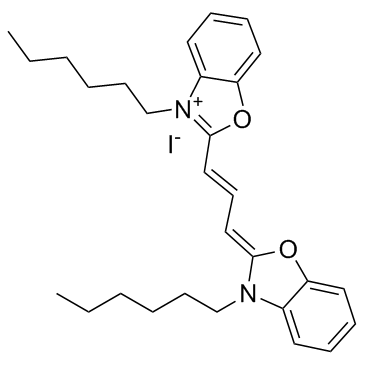3,3'-Dihexyloxacarbocyanine iodide

3,3'-Dihexyloxacarbocyanine iodide structure
|
Common Name | 3,3'-Dihexyloxacarbocyanine iodide | ||
|---|---|---|---|---|
| CAS Number | 53213-82-4 | Molecular Weight | 572.52100 | |
| Density | N/A | Boiling Point | N/A | |
| Molecular Formula | C29H37IN2O2 | Melting Point | 219-221 °C(lit.) | |
| MSDS | USA | Flash Point | N/A | |
| Symbol |

GHS07 |
Signal Word | Warning | |
Use of 3,3'-Dihexyloxacarbocyanine iodide3,3'-Dihexyloxacarbocyanine iodide is a carbocyanine dye which can be used to monitor changes in mitochondrial membrane potential. |
| Name | 3,3'-dihexyloxacarbocyanine iodide |
|---|---|
| Synonym | More Synonyms |
| Description | 3,3'-Dihexyloxacarbocyanine iodide is a carbocyanine dye which can be used to monitor changes in mitochondrial membrane potential. |
|---|---|
| Related Catalog | |
| In Vitro | Addition of cells to the cuvette containing 0.25 μM 3,3'-Dihexyloxacarbocyanine iodide (DiOCg(3)) leads to an increase in fluorescence, equilibration is rapid and is complete by 4 min. When f-met-leu-phe (10-7 M) is added to neutrophils preequilibrated with 3,3'-Dihexyloxacarbocyanine iodide, there is a short lag period of 5 seconds. The lag period is followed by a rapid loss of fluorescence. Examination of 3,3'-Dihexyloxacarbocyanine iodide loaded neutrophils using fluorescence microscopy demonstrates that in resting neutrophils the brightest fluorescence is associated with long thin organelles which corresponds to the distribution of mitochondria[1]. |
| Cell Assay | Neutrophils (2.5×106/mL) are preequilibrated in 0.25 μM 3,3'-Dihexyloxacarbocyanine iodide (DiOCg(3)) for 5 min at 37°C in a 1 cm path length cuvette. Final volume is 2 mL. Fluorescence measurements are made in a spectrofluorimeter (emission wavelength: 510 nm, excitation wavelength: 470 nm). Stimuli are injected by a syringe through an injection port on the spectrofluorimeter, and their volumes never exceed 5% (v/v)[1]. |
| References |
| Melting Point | 219-221 °C(lit.) |
|---|---|
| Molecular Formula | C29H37IN2O2 |
| Molecular Weight | 572.52100 |
| Exact Mass | 572.19000 |
| PSA | 35.09000 |
| LogP | 4.20760 |
| Symbol |

GHS07 |
|---|---|
| Signal Word | Warning |
| Hazard Statements | H315-H319-H335 |
| Precautionary Statements | P261-P305 + P351 + P338 |
| Personal Protective Equipment | dust mask type N95 (US);Eyeshields;Gloves |
| Hazard Codes | Xi |
| Risk Phrases | R36/37/38 |
| Safety Phrases | S26-S36 |
| RIDADR | NONH for all modes of transport |
| WGK Germany | 3 |
| RTECS | DM5285250 |
|
The architecture and biological function of dual antibody-coated dendrimers: enhanced control of circulating tumor cells and their hetero-adhesion to endothelial cells for metastasis prevention.
Theranostics 4(12) , 1250-63, (2014) Dissemination of circulating tumor cells (CTCs) in blood and their hetero-adhesion to vascular endothelial bed of distant metastatic secondary organs are the critical steps to initiate cancer metastas... |
|
|
Centipedegrass extract induces apoptosis through the activation of caspases and the downregulation of PI3K/Akt and MAPK phosphorylation in leukemia cells.
Int. J. Mol. Med. 35(2) , 511-8, (2014) Acute lymphoblastic leukemia (ALL), which involves the blood and bone marrow, is the most common type of cancer in children younger than 5 years of age. Previous studies have investigated the effects ... |
|
|
[Changes in polarization of myometrial cells plasma and internal mitochondrial membranes under calixarenes action as inhibitors of plasma membrane Na+, K+-ATPase].
Ukr. Biokhim. Zh. 84(6) , 37-48, (2012) The influence of supramolecular macrocyclic compounds--calix[4]arenes C-97, C-99, C-107, which are ouabainomymetic high affinity inhibitors of Na+, K(+)-ATPase, on the polarization level of plasmic an... |
| MFCD00011954 |
| DiOC6(3) [3,3'-Dihexyloxacarbocyanine iodide] |
| 3-hexyl-2-[3-(3-hexyl-1,3-benzoxazol-3-ium-2-yl)prop-2-enylidene]-1,3-benzoxazole,iodide |
| 3-hexyl-2-[3-(3-hexyl-2(3H)benzoxazolylidene)-1-propenyl]benzoxazolium iodide |